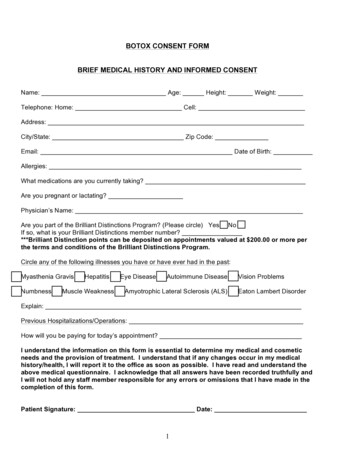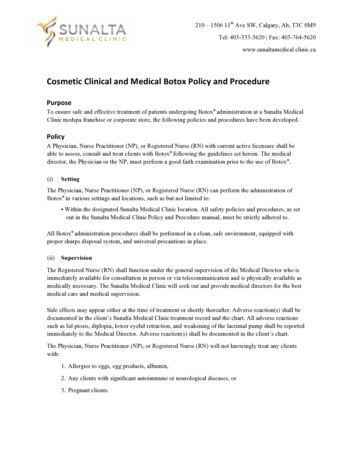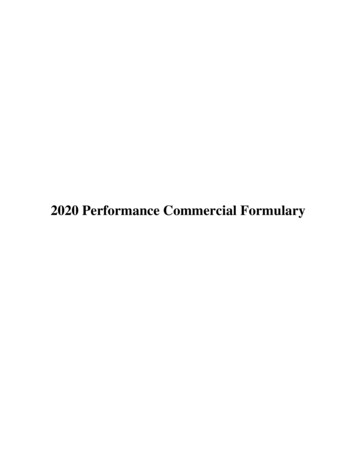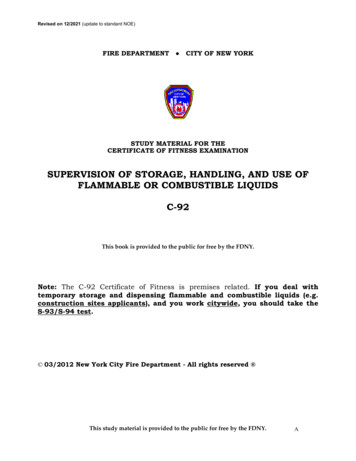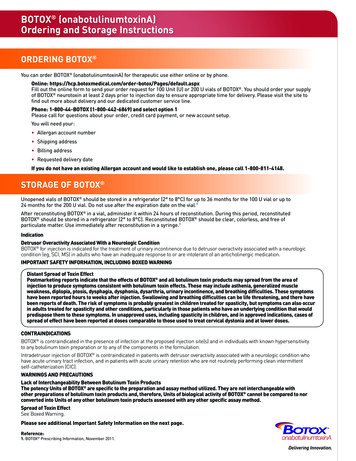
Transcription
BOTOX (onabotulinumtoxinA)Ordering and Storage InstructionsORDERING BOTOX You can order BOTOX (onabotulinumtoxinA) for therapeutic use either online or by phone.Online: ault.aspxFill out the online form to send your order request for 100 Unit (U) or 200 U vials of BOTOX . You should order your supplyof BOTOX neurotoxin at least 2 days prior to injection day to ensure appropriate time for delivery. Please visit the site tofind out more about delivery and our dedicated customer service line.Phone: 1-800-44-BOTOX (1-800-442-6869) and select option 1Please call for questions about your order, credit card payment, or new account setup.You will need your: Allergan account number Shipping address Billing address Requested delivery dateIf you do not have an existing Allergan account and would like to establish one, please call 1-800-811-4148.STORAGE OF BOTOX Unopened vials of BOTOX should be stored in a refrigerator (2 to 8 C) for up to 36 months for the 100 U vial or up to24 months for the 200 U vial. Do not use after the expiration date on the vial.1After reconstituting BOTOX in a vial, administer it within 24 hours of reconstitution. During this period, reconstitutedBOTOX should be stored in a refrigerator (2 to 8 C). Reconstituted BOTOX should be clear, colorless, and free ofparticulate matter. Use immediately after reconstitution in a syringe.1IndicationDetrusor Overactivity Associated With a Neurologic ConditionBOTOX for injection is indicated for the treatment of urinary incontinence due to detrusor overactivity associated with a neurologiccondition (eg, SCI, MS) in adults who have an inadequate response to or are intolerant of an anticholinergic medication.IMPORTANT SAFETY INFORMATION, INCLUDING BOXED WARNINGDistant Spread of Toxin EffectPostmarketing reports indicate that the effects of BOTOX and all botulinum toxin products may spread from the area ofinjection to produce symptoms consistent with botulinum toxin effects. These may include asthenia, generalized muscleweakness, diplopia, ptosis, dysphagia, dysphonia, dysarthria, urinary incontinence, and breathing difficulties. These symptomshave been reported hours to weeks after injection. Swallowing and breathing difficulties can be life threatening, and there havebeen reports of death. The risk of symptoms is probably greatest in children treated for spasticity, but symptoms can also occurin adults treated for spasticity and other conditions, particularly in those patients who have an underlying condition that wouldpredispose them to these symptoms. In unapproved uses, including spasticity in children, and in approved indications, cases ofspread of effect have been reported at doses comparable to those used to treat cervical dystonia and at lower doses.CONTRAINDICATIONSBOTOX is contraindicated in the presence of infection at the proposed injection site(s) and in individuals with known hypersensitivityto any botulinum toxin preparation or to any of the components in the formulation.Intradetrusor injection of BOTOX is contraindicated in patients with detrusor overactivity associated with a neurologic condition whohave acute urinary tract infection, and in patients with acute urinary retention who are not routinely performing clean intermittentself-catheterization (CIC).WARNINGS AND PRECAUTIONSLack of Interchangeability Between Botulinum Toxin ProductsThe potency Units of BOTOX are specific to the preparation and assay method utilized. They are not interchangeable withother preparations of botulinum toxin products and, therefore, Units of biological activity of BOTOX cannot be compared to norconverted into Units of any other botulinum toxin products assessed with any other specific assay method.Spread of Toxin EffectSee Boxed Warning.Please see additional Important Safety Information on the next page.Reference:1. BOTOX Prescribing Information, November 2011.
Important Safety Information (cont.)WARNINGS AND PRECAUTIONS (cont.)Hypersensitivity ReactionsSerious and/or immediate hypersensitivity reactions have beenreported. These reactions include anaphylaxis, serum sickness,urticaria, soft-tissue edema, and dyspnea. If such a reactionoccurs, further injection of BOTOX should be discontinued andappropriate medical therapy immediately instituted. One fatalcase of anaphylaxis has been reported in which lidocaine wasused as the diluent, and consequently the causal agent cannotbe reliably determined.Pre-Existing Neuromuscular DisordersIndividuals with peripheral motor neuropathic diseases,amyotrophic lateral sclerosis, or neuromuscular junctionaldisorders (eg, myasthenia gravis or Lambert-Eaton syndrome)should be monitored particularly closely when given botulinumtoxin. Patients with neuromuscular disorders may be at increasedrisk of clinically significant effects including severe dysphagia andrespiratory compromise from therapeutic doses of BOTOX .Pulmonary Effects of BOTOX in Patients With CompromisedRespiratory Status Treated for Detrusor Overactivity AssociatedWith a Neurologic ConditionPatients with compromised respiratory status treated withBOTOX for detrusor overactivity associated with a neurologiccondition should be monitored closely.Autonomic Dysreflexia and Urinary Retention in Patients Treatedfor Detrusor Overactivity Associated With a Neurologic ConditionAutonomic dysreflexia associated with intradetrusor injections ofBOTOX could occur in patients treated for detrusor overactivityassociated with a neurologic condition and may require promptmedical therapy. In clinical trials, the incidence of autonomicdysreflexia was greater in patients treated with BOTOX 200 Unitscompared with placebo (1.5% versus 0.4%, respectively).In clinical trials, 30.6% of patients (33/108) who were not usingclean intermittent catheterization (CIC) prior to injection, requiredcatheterization for urinary retention following treatment withBOTOX 200 Units as compared to 6.7% of patients (7/104) treatedwith placebo. The median duration of post-injection catheterizationfor these patients treated with BOTOX 200 Units (n 108) was289 days (minimum 1 day to maximum 530 days) as compared toa median duration 358 days (minimum 2 days to maximum379 days) for patients receiving placebo (n 104).Among patients not using CIC at baseline, those with MS weremore likely to require CIC post-injection than those with SCI.Due to the risk of urinary retention, only patients who are willingand/or able to initiate catheterization post-treatment, if required,should be considered for treatment.In patients who are not catheterizing, post-void residual (PVR)urine volume should be assessed within 2 weeks post-treatmentand periodically as medically appropriate up to 12 weeks.Catheterization should be instituted if PVR urine volume exceeds200 mL and continued until PVR falls below 200 mL. Patientsshould be instructed to contact their physician if they experiencedifficulty in voiding as catheterization may be required. 2011 Allergan, Inc., Irvine, CA 92612 marks owned by Allergan, Inc.www.BOTOXMedical.com/HCP 1-800-44-BOTOX APC85JO12 ALBNUI53313Human Albumin and Transmission of Viral DiseasesThis product contains albumin, a derivative of human blood.Based on effective donor screening and product manufacturingprocesses, it carries an extremely remote risk for transmissionof viral diseases. A theoretical risk for transmission of CreutzfeldtJakob disease (CJD) is also considered extremely remote. Nocases of transmission of viral diseases or CJD have ever beenreported for albumin.ADVERSE REACTIONSThe following adverse reactions to BOTOX for injection arediscussed in greater detail in the following sections: Spread ofToxin Effect (see Boxed Warning) and Hypersensitivity Reactions(see Contraindications and Warnings and Precautions).Detrusor Overactivity Associated With a Neurologic ConditionThe most frequently reported adverse reactions within 12 weeksof BOTOX injection for detrusor overactivity associated witha neurologic condition include urinary tract infection (BOTOX 24%, placebo 17%), urinary retention (BOTOX 17%, placebo 3%),hematuria (BOTOX 4%, placebo 3%), fatigue (BOTOX 4%,placebo 1%), and insomnia (BOTOX 2%, placebo 0%).The following adverse event rates were reported at any timefollowing initial injection and prior to reinjection or study exit(median duration of 44 weeks of exposure): urinary tractinfections (49%), urinary retention (17%), fatigue (6%), constipation(4%), muscular weakness (4%), dysuria (4%), fall (3%), gaitdisturbance (3%), insomnia (3%), and muscle spasm (2%).Post Marketing ExperienceThere have been spontaneous reports of death, sometimesassociated with dysphagia, pneumonia, and/or other significantdebility or anaphylaxis, after treatment with botulinum toxin.There have also been reports of adverse events involving thecardiovascular system, including arrhythmia and myocardialinfarction, some with fatal outcomes. Some of these patientshad risk factors including cardiovascular disease. The exactrelationship of these events to the botulinum toxin injection hasnot been established.DRUG INTERACTIONSNo formal drug interaction studies have been conducted withBOTOX (onabotulinumtoxinA) for injection. Co-administrationof BOTOX and aminoglycosides or other agents interfering withneuromuscular transmission (e.g. curare-like compounds) shouldonly be performed with caution as the effect of the toxin may bepotentiated. Use of anticholinergic drugs after administration ofBOTOX may potentiate systemic anticholinergic effects. The effectof administering different botulinum neurotoxin products at thesame time or within several months of each other is unknown.Excessive neuromuscular weakness may be exacerbated byadministration of another botulinum toxin prior to the resolution ofthe effects of a previously administered botulinum toxin. Excessiveweakness may also be exaggerated by administration of a musclerelaxant before or after administration of BOTOX .Please see the accompanying full Prescribing Information,including Boxed Warning and Medication Guide.
HIGHLIGHTS OF PRESCRIBING INFORMATIONThese highlights do not include all the information needed to useBOTOX safely and effectively. See full prescribing informationfor BOTOX.BOTOX (onabotulinumtoxinA) for injection, for intramuscular,intradetrusor, or intradermal useInitial U.S. Approval: 1989WARNING: DISTANT SPREAD OF TOXIN EFFECTSee full prescribing information for complete boxed warning.The effects of BOTOX and all botulinum toxin products may spreadfrom the area of injection to produce symptoms consistent withbotulinum toxin effects. These symptoms have been reported hoursto weeks after injection. Swallowing and breathing difficulties canbe life threatening and there have been reports of death. The risk ofsymptoms is probably greatest in children treated for spasticity butsymptoms can also occur in adults, particularly in those patientswho have an underlying condition that would predispose them tothese symptoms. (5.2)RECENT MAJOR CHANGES I ndications and Usage, Detrusor Overactivity associated with a NeurologicCondition (1.1) 8/2011 Dosage and Administration, Detrusor Overactivity associated with aNeurologic Condition (2.3) 8/2011 Contraindications, Acute Urinary Tract Infection and Acute UrinaryRetention (4.3) 8/2011 Warnings and Precautions, Injections In or Near Vulnerable AnatomicStructures (5.3) 11/2011 Warnings and Precautions, Autonomic Dysreflexia and Urinary Retentionin Patients Treated for Detrusor Overactivity associated with a NeurologicCondition (5.11) 8/2011INDICATIONS AND USAGEBOTOX is an acetylcholine release inhibitor and a neuromuscular blockingagent indicated for: Treatment of urinary incontinence due to detrusor overactivity associatedwith a neurologic condition [e.g., spinal cord injury (SCI), multiple sclerosis(MS)] in adults who have an inadequate response to or are intolerant ofan anticholinergic medication (1.1) Prophylaxis of headaches in adult patients with chronic migraine ( 15 daysper month with headache lasting 4 hours a day or longer) (1.2) Treatment of upper limb spasticity in adult patients (1.3) Treatment of cervical dystonia in adult patients, to reduce the severityof abnormal head position and neck pain (1.4) Treatment of severe axillary hyperhidrosis that is inadequately managedby topical agents in adult patients (1.5) Treatment of blepharospasm associated with dystonia in patients 12 yearsof age (1.6) Treatment of strabismus in patients 12 years of age (1.6)Important limitations: Safety and effectiveness of BOTOX have not been established for theprophylaxis of episodic migraine (14 headache days or fewer per month).(1.2) Safety and effectiveness of BOTOX have not been established forthe treatment of upper limb spasticity in pediatric patients, and for thetreatment of lower limb spasticity in adult and pediatric patients. (1.3) Safety and effectiveness of BOTOX for hyperhidrosis in body areas otherthan axillary have not been established. (1.5)DOSAGE AND ADMINISTRATION Indication specific dosage and administration recommendations shouldbe followed; Do not exceed a total dose of 360 Units administered ina 3 month interval (2.1) See Preparation and Dilution Technique for instructions on BOTOXreconstitution, storage, and preparation before injection (2.2) Detrusor Overactivity associated with a Neurologic Condition:Recommended total dose 200 Units, as 1 mL ( 6.7 Units) injectionsacross 30 sites into the detrusor (2.3) Chronic Migraine: Recommended total dose 155 Units, as 0.1 mL (5 Units)injections per each site divided across 7 head/neck muscles (2.4)FULL PRESCRIBING INFORMATION: CONTENTS*WARNING: DISTANT SPREAD OF TOXIN EFFECT1 INDICATIONS AND USAGE1.1Detrusor Overactivity associated with a Neurologic Condition1.2Chronic Migraine1.3Upper Limb Spasticity1.4Cervical Dystonia1.5Primary Axillary Hyperhidrosis1.6Blepharospasm and Strabismus2 DOSAGE AND ADMINISTRATION2.1 Instructions for Safe Use2.2 Preparation and Dilution Technique U pper Limb Spasticity: Select dose based on muscles affected, severityof muscle activity, prior response to treatment, and adverse event history;Electromyographic guidance recommended (2.5) Cervical Dystonia: Base dosing on the patient’s head and neck position,localization of pain, muscle hypertrophy, patient response, and adverseevent history; use lower initial dose in botulinum toxin naïve patients (2.6) Axillary Hyperhidrosis: 50 Units per axilla (2.7) Blepharospasm: 1.25 Units-2.5 Units into each of 3 sites per affectedeye (2.8) Strabismus: 1.25 Units-2.5 Units initially in any one muscle (2.9)DOSAGE FORMS AND STRENGTHSSingle-use, sterile 100 Units or 200 Units vacuum-dried powder forreconstitution only with sterile, non-preserved 0.9% Sodium ChlorideInjection USP prior to injection (3)CONTRAINDICATIONS Hypersensitivity to any botulinum toxin preparation or to any of thecomponents in the formulation (4.1, 5.4, 6) Infection at the proposed injection site (4.2) Intradetrusor Injections: Acute Urinary Tract Infection and/or AcuteUrinary Retention (4.3)WARNINGS AND PRECAUTIONS Potency Units of BOTOX not interchangeable with other preparationsof botulinum toxin products (5.1, 11) Spread of toxin effects; swallowing and breathing difficulties can leadto death. Seek immediate medical attention if respiratory, speechor swallowing difficulties occur (5.2, 5.5) Care should be taken when injecting in or near vulnerable anatomicstructures (5.3) Concomitant neuromuscular disorder may exacerbate clinical effectsof treatment (5.6) Use with caution in patients with compromised respiratory function(5.5, 5.7, 5.10) Corneal exposure and ulceration due to reduced blinking may occurwith BOTOX treatment of blepharospasm (5.8) Retrobulbar hemorrhages and compromised retinal circulation may occurwith BOTOX treatment of strabismus (5.9) Bronchitis and upper respiratory tract infections in patients treatedfor upper limb spasticity (5.10) Urinary retention: Post-void residual urine volume should be monitoredin patients treated for detrusor overactivity associated with a neurologiccondition who do not catheterize routinely, particularly patients with MS.(5.11)ADVERSE REACTIONSThe most common adverse reactions ( 5% and placebo) are (6.1): Detrusor Overactivity associated with a neurologic condition: urinarytract infection, urinary retention Chronic Migraine: neck pain, headache Spasticity: pain in extremity Cervical Dystonia: dysphagia, upper respiratory infection, neck pain,headache, increased cough, flu syndrome, back pain, rhinitis Axillary Hyperhidrosis: injection site pain and hemorrhage, non-axillarysweating, pharyngitis, flu syndromeTo report SUSPECTED ADVERSE REACTIONS, contact Allergan at1-800-433-8871 or FDA at 1-800-FDA-1088 or www.fda.gov/medwatch.DRUG INTERACTIONS Patients receiving concomitant treatment of BOTOX and aminoglycosidesor other agents interfering with neuromuscular transmission (e.g., curarelike agents), or muscle relaxants, should be observed closely because theeffect of BOTOX may be potentiated (7)USE IN SPECIFIC POPULATIONS Pregnancy: Based on animal data, may cause fetal harm (8.1) Pediatric Use: Safety and efficacy are not established in patients under18 years of age for the prophylaxis of headaches in chronic migraine, thetreatment of detrusor overactivity associated with a neurologic condition,upper limb spasticity, and axillary hyperhidrosis, in patients under 16 yearsof age for the treatment of cervical dystonia, and in patients under 12 yearsof age for the treatment of blepharospasm and strabismus (8.4)See 17 for PATIENT COUNSELING INFORMATION and Medication GuideRevised: 11/20112.3 Detrusor Overactivity associated with a Neurologic Condition2.4 Chronic Migraine2.5 Upper Limb Spasticity2.6 Cervical Dystonia2.7 Primary Axillary Hyperhidrosis2.8 Blepharospasm2.9 Strabismus3 DOSAGE FORMS AND STRENGTHS4 CONTRAINDICATIONS4.1 Known Hypersensitivity to Botulinum Toxin4.2 Infection at the Injection Site(s)4.3 Acute Urinary Tract Infection and/or Acute Urinary Retention
5 WARNINGS AND PRECAUTIONS5.1 Lack of Interchangeability between Botulinum Toxin Products5.2 Spread of Toxin Effect5.3 Injections In or Near Vulnerable Anatomic Structures5.4 Hypersensitivity Reactions5.5 Dysphagia and Breathing Difficulties in Treatment of Cervical Dystonia5.6 Pre-Existing Neuromuscular Disorders5.7 Pulmonary Effects of BOTOX in Patients with CompromisedRespiratory Status Treated for Spasticity or for Detrusor Overactivityassociated with a Neurologic Condition5.8 Corneal Exposure and Ulceration in Patients Treated with BOTOXfor Blepharospasm5.9 Retrobulbar Hemorrhages in Patients Treated with BOTOXfor Strabismus5.10 Bronchitis and Upper Respiratory Tract Infections in Patients Treatedfor Spasticity5.11 Autonomic Dysreflexia and Urinary Retention in Patients Treatedfor Detrusor Overactivity associated with a Neurologic Condition5.12 Human Albumin and Transmission of Viral Diseases6 ADVERSE REACTIONS6.1 Clinical Trials Experience6.2 Immunogenicity6.3 Post-Marketing Experience7 DRUG INTERACTIONS8 USE IN SPECIFIC POPULATIONS8.1 Pregnancy8.3 Nursing Mothers8.4 Pediatric Use8.5 Geriatric Use10 OVERDOSAGE11 DESCRIPTION12 CLINICAL PHARMACOLOGY12.1 Mechanism of Action12.3 Pharmacokinetics13 NONCLINICAL TOXICOLOGY13.1 Carcinogenesis, Mutagenesis, Impairment of Fertility13.2 Animal Toxicology14 CLINICAL STUDIES14.1 Detrusor Overactivity associated with a Neurologic Condition14.2 Chronic Migraine14.3 Upper Limb Spasticity14.4 Cervical Dystonia14.5 Primary Axillary Hyperhidrosis14.6 Blepharospasm14.7 Strabismus16 HOW SUPPLIED/STORAGE AND HANDLING17 PATIENT COUNSELING INFORMATION17.1 Swallowing, Speaking or Breathing Difficulties, or OtherUnusual Symptoms17.2 Ability to Operate Machinery or Vehicles17.3 Voiding Difficulties after Bladder InjectionsFULL PRESCRIBING INFORMATION1.5 Primary Axillary HyperhidrosisBOTOX is indicated for the treatment of severe primary axillary hyperhidrosisthat is inadequately managed with topical agents.Important limitationsThe safety and effectiveness of BOTOX for hyperhidrosis in other body areashave not been established. Weakness of hand muscles and blepharoptosismay occur in patients who receive BOTOX for palmar hyperhidrosis and facialhyperhidrosis, respectively. Patients should be evaluated for potential causesof secondary hyperhidrosis (e.g., hyperthyroidism) to avoid symptomatictreatment of hyperhidrosis without the diagnosis and/or treatment of theunderlying disease.Safety and effectiveness of BOTOX have not been established for thetreatment of axillary hyperhidrosis in pediatric patients under age 18.WARNING: DISTANT SPREAD OF TOXIN EFFECTPostmarketing reports indicate that the effects of BOTOX and allbotulinum toxin products may spread from the area of injection toproduce symptoms consistent with botulinum toxin effects. Thesemay include asthenia, generalized muscle weakness, diplopia,ptosis, dysphagia, dysphonia, dysarthria, urinary incontinence andbreathing difficulties. These symptoms have been reported hoursto weeks after injection. Swallowing and breathing difficulties canbe life threatening and there have been reports of death. The risk ofsymptoms is probably greatest in children treated for spasticity butsymptoms can also occur in adults treated for spasticity and otherconditions, particularly in those patients who have an underlyingcondition that would predispose them to these symptoms. Inunapproved uses, including spasticity in children, and in approvedindications, cases of spread of effect have been reported at dosescomparable to those used to treat cervical dystonia and at lowerdoses. [See Warnings and Precautions (5.2)]1INDICATIONS AND USAGE1.1 Detrusor Overactivity associated with a Neurologic ConditionBOTOX (onabotulinumtoxinA) for injection is indicated for the treatment ofurinary incontinence due to detrusor overactivity associated with a neurologiccondition (e.g., SCI, MS) in adults who have an inadequate response to or areintolerant of an anticholinergic medication.1.2 Chronic MigraineBOTOX is indicated for the prophylaxis of headaches in adult patients withchronic migraine ( 15 days per month with headache lasting 4 hours a dayor longer).Important limitationsSafety and effectiveness have not been established for the prophylaxisof episodic migraine (14 headache days or fewer per month) in sevenplacebo-controlled studies.1.3 Upper Limb SpasticityBOTOX is indicated for the treatment of upper limb spasticity in adult patients,to decrease the severity of increased muscle tone in elbow flexors (biceps),wrist flexors (flexor carpi radialis and flexor carpi ulnaris) and finger flexors(flexor digitorum profundus and flexor digitorum sublimis).Important limitationsSafety and effectiveness of BOTOX have not been established for thetreatment of other upper limb muscle groups, or for the treatment of lower limbspasticity. Safety and effectiveness of BOTOX have not been established forthe treatment of spasticity in pediatric patients under age 18 years. BOTOXhas not been shown to improve upper extremity functional abilities, or rangeof motion at a joint affected by a fixed contracture. Treatment with BOTOX isnot intended to substitute for usual standard of care rehabilitation regimens.1.4 Cervical DystoniaBOTOX is indicated for the treatment of adults with cervical dystonia,to reduce the severity of abnormal head position and neck pain associatedwith cervical dystonia.* Sections or subsections omitted from the full prescribing informationare not listed1.6 Blepharospasm and StrabismusBOTOX is indicated for the treatment of strabismus and blepharospasmassociated with dystonia, including benign essential blepharospasmor VII nerve disorders in patients 12 years of age and above.2DOSAGE AND ADMINISTRATION2.1 Instructions for Safe UseThe potency Units of BOTOX (onabotulinumtoxinA) for injection arespecific to the preparation and assay method utilized. They are notinterchangeable with other preparations of botulinum toxin productsand, therefore, units of biological activity of BOTOX cannot be comparedto nor converted into units of any other botulinum toxin productsassessed with any other specific assay method [see Warnings andPrecautions (5.1) and Description (11)].Indication specific dosage and administration recommendations should befollowed. In treating adult patients for one or more indications, the maximumcumulative dose should generally not exceed 360 Units, in a 3 month interval.The safe and effective use of BOTOX depends upon proper storageof the product, selection of the correct dose, and proper reconstitutionand administration techniques. Physicians administering BOTOX mustunderstand the relevant neuromuscular and/or orbital anatomy of the areainvolved and any alterations to the anatomy due to prior surgical procedures.An understanding of standard electromyographic techniques is also requiredfor treatment of strabismus and of upper limb spasticity, and may be usefulfor the treatment of cervical dystonia.Use caution when BOTOX treatment is used in the presence of inflammationat the proposed injection site(s) or when excessive weakness or atrophyis present in the target muscle(s).2.2 Preparation and Dilution TechniqueBOTOX is supplied in single-use 100 Units and 200 Units per vial. Priorto injection, reconstitute each vacuum-dried vial of BOTOX with sterile,non-preserved 0.9% Sodium Chloride Injection USP. Draw up the properamount of diluent in the appropriate size syringe (see Table 1, or for specificinstructions for detrusor overactivity associated with a neurologic conditionsee Section 2.3), and slowly inject the diluent into the vial. Discard the vialif a vacuum does not pull the diluent into the vial. Gently mix BOTOX withthe saline by rotating the vial. Record the date and time of reconstitutionon the space on the label. BOTOX should be administered within 24 hoursafter reconstitution. During this time period, reconstituted BOTOX shouldbe stored in a refrigerator (2 to 8 C).
Table 1: Dilution Instructions for BOTOX Vials (100 Units and 200 Units)Diluent*Added to100 Unit VialResultingDose Unitsper 0.1 mLDiluent*Added to200 Unit VialResultingDose Unitsper 0.1 mL1 mL10 Units1 mL20 Units2 mL5 Units2 mL10 Units4 mL2.5 Units4 mL5 Units8 mL1.25 Units8 mL2.5 Units10 mL2 Units*Preservative-free 0.9% Sodium Chloride Injection, USP OnlyNote: These dilutions are calculated for an injection volume of 0.1 mL. Adecrease or increase in the BOTOX dose is also possible by administeringa smaller or larger injection volume - from 0.05 mL (50% decrease in dose)to 0.15 mL (50% increase in dose).An injection of BOTOX is prepared by drawing into an appropriately sizedsterile syringe an amount of the properly reconstituted toxin slightly greaterthan the intended dose. Air bubbles in the syringe barrel are expelled andthe syringe is attached to an appropriate injection needle. Patency of theneedle should be confirmed. A new, sterile, needle and syringe should beused to enter the vial on each occasion for removal of BOTOX.Reconstituted BOTOX should be clear, colorless, and free of particulatematter. Parenteral drug products should be inspected visually for particulatematter and discoloration prior to administration and whenever the solutionand the container permit.2.3 Detrusor Overactivity associated with a Neurologic ConditionPatients should not have an acute urinary tract infection prior to treatment.Prophylactic antibiotics (except aminoglycosides, see Drug Interactions (7))should be administered 1-3 days pre-treatment, on the treatment day, and1-3 days post-treatment.Patients should discontinue anti-platelet therapy at least 3 days beforethe injection procedure. Patients on anti-coagulant therapy need to bemanaged appropriately to decrease the risk of bleeding.Appropriate caution should be exercised when performing a cystoscopy.An intravesical instillation of diluted local anesthetic with or without sedation,or general anesthesia may be used prior to injection, per local site practice.If a local anesthetic instillation is performed, the bladder should be drainedand irrigated with sterile saline before injection.The recommended dose is 200 Units of BOTOX per treatment, and shouldnot be exceeded.Reconstitute a 200 Unit vial of BOTOX with 6 mL of 0.9% non-preservedsaline solution and mix the vial gently. Draw 2 mL from the vial into eachof three 10 mL syringes. Complete the reconstitution by adding 8 mL of0.9% non-preserved saline solution into each of the 10 mL syringes, andmix gently. This will result in three 10 mL syringes each containing 10 mL( 67 Units in each), for a total of 200 Units of reconstituted BOTOX. Useimmediately after reconstitution in the syringe. Dispose of any unused saline.Alternatively, reconstitute two 100 Unit vials of BOTOX, each with 6 mL of0.9% non-preserved saline solution and mix the vials gently. Draw 4 mL fromeach vial into each of two 10 mL syringes. Draw the remaining 2 mL fromeach vial into a third 10 mL syringe. Complete the reconstitution by adding6 mL of 0.9% non-preserved saline solution into each of the 10 mL syringes,and mix gently. This will result in three 10 mL syringes each containing 10 mL( 67 Units in each), for a total of 200 Units of reconstituted BOTOX. Useimmediately after reconstitution in the syringe. Dispose of any unused saline.Reconstituted BOTOX (200 Units/30 mL) is injected into the detrusormuscle via a flexible or rigid cystoscope, avoiding the trigone. The bladdershould be instilled with enough saline to achieve adequate visualizationfor the injections, but over-distension should be avoided.The injection needle should be filled (primed) with approximately 1 mLof reconstituted BOTOX prior to the start of injections (depending on theneedle length) to rem
WARNINGS AND PRECAUTIONS (cont.) Hypersensitivity Reactions Serious and/or immediate hypersensitivity reactions have been reported. These reactions include anaphylaxis, serum sickness,
